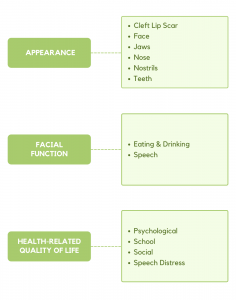Research
Field-tested in sample of 2434 patients with cleft lip and/or palate in 12 countries.
The CLEFT-Q was developed from 138 concept elicitation interviews with children and young adults with cleft lip and/or palate from 6 countries. To establish content validity, we conducted 69 cognitive interviews and obtained input from 44 international experts. The CLEFT-Q was then field-tested in an international sample of 2434 patients from 30 hospitals in 12 countries.

The CLEFT-Q is for anyone with cleft lip and/or palate aged 8 to 29 years. The CLEFT-Q has an eating/drinking checklist and 12 scales that measure 3 overarching domains. The variety of scales provides flexibility to choose the subset of scales best suited to measure the outcomes of interest in any given study or clinical situation.
Field-tested in sample of 2434 patients with cleft lip and/or palate in 12 countries.
Can be used in international clinical trials of craniofacial treatments.
Included in ICHOM Standard Sets for craniofacial conditions to enable hospitals around the world to compare outcomes.
Designed using a modern psychometric approach to facilitate use in patient care.
The CLEFT-Q is a rigorously developed patient-reported outcome (PRO) measure that can be used internationally to collect and compare evidence-based outcomes data from patients ages 8 to 29 years with cleft lip and/or palate. The CLEFT-Q measures 3 overarching domains. Each domain is composed of 1 or more independently functioning scales. Clinicians and researchers are able to administer the subset of scales relevant to their situation.
Seven scales measure aspects of appearance that are addressed by cleft-specific treatments, including the face overall, lips, jaw, nose, nostrils, teeth and cleft lip scar.
A speech scale measures problems with speaking, such as having trouble with words or sentences, and having to speak slowly. A checklist measures eating and drinking problems, such as having food get stuck in a hole in the mouth.
Four scales measure aspects of health-related quality of life, including psychological, social and school function and speech-related distress.


